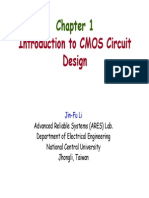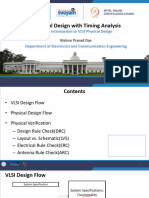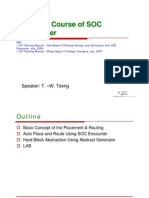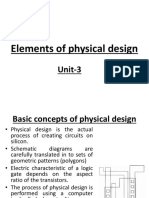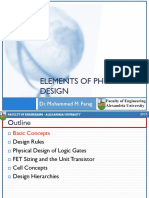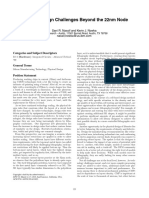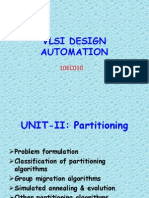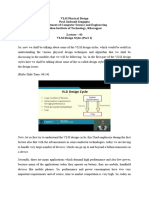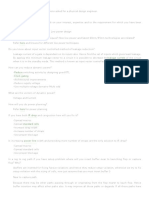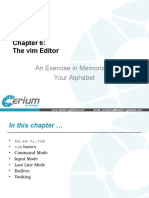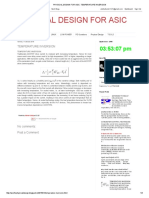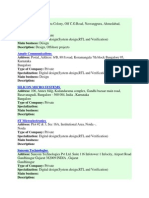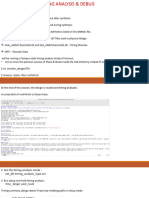Chapter 5
Elements of Physical Design
Jin-Fu Li
Advanced Reliable Systems (ARES) Lab.
Department of Electrical Engineering
National Central University
Jhongli, Taiwan
�Outline
Basic Concepts
Layout of Basic Structures
Cell Concepts
MOS Sizing
Physical Design of Logic Gates
Design Hierarchies
Advanced Reliable Systems (ARES) Lab.
Jin-Fu Li, EE, NCU
�Basic Concepts
Physical design
The actual process of creating circuits on silicon
During this phase, schematic diagrams are carefully
translated into sets of geometric patterns that are
used to define the on-chip physical structures
Every layer in the CMOS fabrication sequence is
defined by a distinct pattern
The process of physical design is performed using
a computer tool called a layout editor
A graphics program that allows the designer to specify
the shape, dimensions, and placement
Complexity issues are attacked by first designing
simple gates and storing their descriptive files in
a library subdirectory or folder
Advanced Reliable Systems (ARES) Lab.
Jin-Fu Li, EE, NCU
�Basic Concepts
The gates constitute cells in the library
Library cells are used as building blocks by
creating copies of the basic cells to
construct a larger more complex circuit
This process is called instantiate of the cell
A copy of a cell is called an instance
Much of the designers work is directed
toward the goal of obtaining a fast circuit in
the minimum amount of area
Small changes in the shapes or area of a polygon
will affect the resulting electrical characteristics
of the circuit
Advanced Reliable Systems (ARES) Lab.
Jin-Fu Li, EE, NCU
�CAD Toolsets
Physical design is based on the use of CAD
tools
Simplify the procedure and aid in the verification
process
Physical design toolsets
Layout editor
Extraction routine
Layout versus schematic (LVS)
Design rule checker (DRC)
Place and route routine
Electrical rule checker (ERC)
Advanced Reliable Systems (ARES) Lab.
Jin-Fu Li, EE, NCU
�Layout of Basic Structures
The masking sequence of the P-substrate
technology was established as
Start with P-type substrate
nWell
Active
Poly
pSelect
nSelect
Active Contact
Poly contact
Metal1
Via
Metal2
Advanced Reliable Systems (ARES) Lab.
Jin-Fu Li, EE, NCU
�Layout of Basic Structures
It is worth remembering that the features on
every level have design rule specifications for
the minimum width w of a line, and a minimum
edge-to-edge spacing s between adjacent
polygons
For example,
w
Advanced Reliable Systems (ARES) Lab.
Jin-Fu Li, EE, NCU
�Design Rules
Design rules (layout rules)
Provide a necessary communication link between
circuit designers and process engineers during
manufacturing phase
The goal of design rules is to achieve the optimum
yield of a circuit with the smallest area cost
Design rules specify to the designer certain
geometric constraints on the layout artwork
so that the patterns on the processed wafer
will preserve the topology and geometry of
the designs
Advanced Reliable Systems (ARES) Lab.
Jin-Fu Li, EE, NCU
�Design Rules
The design rules primarily address two issues
The geometrical reproduction of features that can
be reproduced by the mask-making and
lithographical process
The interactions between different layers
Lambda-based rules
Based on a single parameter, lambda, which
characterizes the linear feature the resolution
of the complete wafer implementation process
Advanced Reliable Systems (ARES) Lab.
Jin-Fu Li, EE, NCU
�Examples of Design Rules
Different Potential
Same Potential
0
or
6
Well
10
Active
Polysilicon
3
2
3
Metal1
Contact
or Via
Hole
2
3
Advanced Reliable Systems (ARES) Lab.
Jin-Fu Li, EE, NCU
10
�Transistor
Transistor Layout
Advanced Reliable Systems (ARES) Lab.
Jin-Fu Li, EE, NCU
11
�Design Rules for Vias & Contacts
2
4
Via
1
1
5
Metal to
1
Active Contact
Metal to
Poly Contact
3
2
2
Advanced Reliable Systems (ARES) Lab.
Jin-Fu Li, EE, NCU
12
�Design Rule Checker
Advanced Reliable Systems (ARES) Lab.
Jin-Fu Li, EE, NCU
13
�Layouts of PMOS & NMOS
NMOS
L
Poly
n+
n+
n+
Poly
n+
PMOS
L
Poly
p+
p+
p+
Poly
p+
N-well
P
Advanced Reliable Systems (ARES) Lab.
N-well
Jin-Fu Li, EE, NCU
14
�The Layout of a CMOS Inverter
A transistor-level CMOS inverter & the
corresponding layout
Vdd
Vdd
Vout
Vin
Vout
Vin
Vss
Vss
Advanced Reliable Systems (ARES) Lab.
Jin-Fu Li, EE, NCU
15
�Layouts of a 2-Input NAND Gate
Vdd
Vdd
z
z
a
b
a
b
Vss
Advanced Reliable Systems (ARES) Lab.
Jin-Fu Li, EE, NCU
Vss
16
�Layouts of a 2-Input NOR Gate
Vdd
a
b
Vdd
Vss
Vss
b
Advanced Reliable Systems (ARES) Lab.
Jin-Fu Li, EE, NCU
17
�Cell Concepts
The basic building blocks in physical design
are called cells
Logic gates as basic cells
XNOT
Vdd
XNAND2
Vdd
in
out
Vss
Vss
Vdd
XNOR2
Vdd
in1
out
in2
Vss
Vss
Vdd
in1
in2
Vss
Vdd
out
Vss
Note that power supply ports for Vdd and Vss are
chosen to be at the same locations for every cell
The width of each cell depends on the transistor
sizes and wiring used at the physical level
Advanced Reliable Systems (ARES) Lab.
Jin-Fu Li, EE, NCU
18
�Cell Creation Using Primitive Cells
Create a new cell providing the function
f=ab
Vdd
a
b
Vss
2XNOT+XNAND2
Vdd
f
a
b
Vss
Advanced Reliable Systems (ARES) Lab.
Jin-Fu Li, EE, NCU
19
�Layout of Cells
Vdd & Vss power supply lines
Vdd
PMOSs
nWell
Dm1-m1
P-substrate
Pm1-m1
NMOSs
Vss
Dm1-m1: edge-to-edge distance between Vdd and Vss
Pm1-m1: distance between the middle of the Vdd and
Vss lines
Pm1-m1=Dm1-m1+Wdd, where Wdd is the width of the
power supply lines
Advanced Reliable Systems (ARES) Lab.
Jin-Fu Li, EE, NCU
20
�Layout of Cells
Layout styles of transistors
Vdd
WP
WP
Wn
Wn
Vss
Advanced Reliable Systems (ARES) Lab.
Jin-Fu Li, EE, NCU
21
�Effect of Layout Shapes
Larger spacing between Vdd and Vss
Vdd
Vss
Smaller spacing between Vdd and Vss
Vdd
A
Vss
Advanced Reliable Systems (ARES) Lab.
Jin-Fu Li, EE, NCU
22
�Routing Channels
Interconnection routing considerations are very
important considerations for the Vss-Vdd spacing
In complex digital systems, the wiring is often more
complicated than designing the transistor arrays
The general idea for routing
Metal3
Wiring
Vdd
Vss
cell1
cell2
cell3
cell4
cell5
Routing
Channel
Metal1
Wiring
Vdd
Vss
cell7
cell6
cell8
cell9
Routing
Channel
Metal2
Wiring
Metal1
Wiring
Vdd
Vss
cell10
cell11
Advanced Reliable Systems (ARES) Lab.
cell12
Jin-Fu Li, EE, NCU
cell13
23
�High-Density Techniques
Alternate Vdd and Vss power lines and share
them with cells above and below
For example,
Vdd
Vss
Vdd
Vss
Vdd
Logic cells
Inverted logic cells
Logic cells
Inverted logic cells
Since no space is automatically reserved for routing,
this scheme allows for high-density of placement of
cells
The main drawback is that the connection between
rows must be accomplished by using Metal2 or higher
Advanced Reliable Systems (ARES) Lab.
Jin-Fu Li, EE, NCU
24
�High-Density Techniques
MOS transistor placement
PMOS transistors
Vdd
nWell
PMOS transistors
P-substrate
NMOS transistors
P-substrate
NMOS transistors
Vss
nWell
PMOS transistors
Vdd
PMOS transistors
Advanced Reliable Systems (ARES) Lab.
Jin-Fu Li, EE, NCU
25
�Port Placement
An example of the port placement in a cell
Vdd
Metal1
input
Metal1
output
Vss
To routing channel
Advanced Reliable Systems (ARES) Lab.
Jin-Fu Li, EE, NCU
26
�MOS Sizing in Physical Design
A minimum-size MOS transistor is the
smallest transistor that can be created using
the design rule set
L
Scaling of the unit transistor
L
L
W
2X
4W
2W
4X
L
W
Advanced Reliable Systems (ARES) Lab.
2X
Jin-Fu Li, EE, NCU
2W
27
�Physical Designs of Complex Gates
Vdd
D
B
A
z
Z
B
Vss
Advanced Reliable Systems (ARES) Lab.
Jin-Fu Li, EE, NCU
28
�Physical Design of XNOR Gate (1)
A
B
Z
Z
Vdd
B
A
Vss
B
Z
Advanced Reliable Systems (ARES) Lab.
Jin-Fu Li, EE, NCU
29
�Physical Design of XNOR Gate (2)
A
B
Z
Vdd
Vss
z
Advanced Reliable Systems (ARES) Lab.
Jin-Fu Li, EE, NCU
30
�Automation of Physical Design
A
E
Vdd
E
D
C
E
B
Vss
Vdd
P
Vss
Advanced Reliable Systems (ARES) Lab.
Jin-Fu Li, EE, NCU
31
�Standard-Cell Physical Design
WVdd
Wp
Dnp
Wn
a
Advanced Reliable Systems (ARES) Lab.
Jin-Fu Li, EE, NCU
WVss
32
�Standard-Cell Physical Design
Vdd
Vdd
Vss
a
Advanced Reliable Systems (ARES) Lab.
Vss
a
Jin-Fu Li, EE, NCU
33
�Gate-Array Physical Design
Vdd
Vss
Advanced Reliable Systems (ARES) Lab.
Jin-Fu Li, EE, NCU
34
�Gate-Array Physical Design
Vdd
Gate array cells
Routing channels
Vss
Advanced Reliable Systems (ARES) Lab.
Jin-Fu Li, EE, NCU
35
�Sea-of-Gate Physical Design
well contacts
Vdd supply
P-transistors
poly gates
N-transistors
Vss supply
substrate contacts
Advanced Reliable Systems (ARES) Lab.
Jin-Fu Li, EE, NCU
36
�Sea-of-Gate Physical Design
a
a
Advanced Reliable Systems (ARES) Lab.
Jin-Fu Li, EE, NCU
37
�CMOS Layout Guidelines
Run VDD and VSS in metal at the top and bottom
of the cell
Run a vertical poly line for each gate input
Order the poly gate signals to allow the
maximal connection between transistors via
abutting source-drain connection
Place n-gate segments close to VSS and p-gate
segments close to VDD
Connection to complete the logic gate should be
made in poly, metal, or, where appropriate, in
diffusion
Advanced Reliable Systems (ARES) Lab.
Jin-Fu Li, EE, NCU
38
�Guidelines for Improving Density
Better use of routing layers routes can
occurs over cells
More merged source-drain connections
More usage of white space in sparse gates
Use of optimum device sizes the use of
smaller devices leads to smaller layouts
Advanced Reliable Systems (ARES) Lab.
Jin-Fu Li, EE, NCU
39
�Layout Optimization
Vary the size of the transistor according to the
position in the structure
Vdd
clk
F
A<0>
F
A<1>
A<2>
A<3>
Vss
clk A<3> A<2> A<1> A<0>
In submicron technologies, where the source/drain
capacitances are less, such that this improvement is
limited
Advanced Reliable Systems (ARES) Lab.
Jin-Fu Li, EE, NCU
40
�Layout Optimization
2
A
A
B
C
D
D
1
Vdd
Right
Wrong
Vss
A
Advanced Reliable Systems (ARES) Lab.
A
Jin-Fu Li, EE, NCU
D
41
�Layouts of Transmission Gates
Advanced Reliable Systems (ARES) Lab.
Jin-Fu Li, EE, NCU
42
�Routing to Transmission Gates
Advanced Reliable Systems (ARES) Lab.
Jin-Fu Li, EE, NCU
43
�2-Input Multiplexer
c
a
z
-c
b
c
Advanced Reliable Systems (ARES) Lab.
-c
Jin-Fu Li, EE, NCU
44
�Design Hierarchies
Layout level
cell1
cell2
celln
Cell library
Subsystems
Module 1
Module m
Module 4
Module 1
Module 3
Module 2
Advanced Reliable Systems (ARES) Lab.
Module 5
Chips
Module 6
Jin-Fu Li, EE, NCU
45
�Summary
Basic physical design concepts have been
introduced
Cell concepts have also presented
Layout optimization guidelines have been
summarized
Design hierarchy has been briefly introduced
Advanced Reliable Systems (ARES) Lab.
Jin-Fu Li, EE, NCU
46

